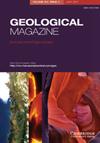Geochemical constraints on the petrogenesis of mafic rocks (metadolerites) from the Proterozoic Shillong Basin, Northeast India: implications for growth of the Greater Indian Landmass
IF 2
3区 地球科学
Q3 GEOSCIENCES, MULTIDISCIPLINARY
引用次数: 0
Abstract
The Paleo-Mesoproterozoic Shillong Basin of the Assam-Meghalaya Gneissic Complex is exposed in parts of Northeast India. The studied metadolerites are from the volcano-sedimentary sequence of Shillong Basin from the Borjuri area in the Mikir Massif. This episode of mafic magmatism can be correlated with the Columbia supercontinent formation and bears significance to its reconstruction. The present work discusses the field, petrography and geochemical characteristics of the metadolerites, which occur in close association with the quartzites of the Shillong Group of rocks (metasedimentary rocks of the Shillong Basin). Our data show distinctive characteristics of subduction-related magmatism exhibiting high LREE/HREE, large ion lithophile element/high field strength element ratios and pronounced negative Nb anomaly. Elemental ratios such as Zr/Ba (0.21–0.46), La/Nb (1.23–2.32) and Ba/Nb (30.08–56.90) point to a fluid-enriched lithospheric mantle source in a subduction regime. Metadolerites plot in the field of ‘back-arc basin basalts’ in tectonic discrimination diagrams reinforcing a subduction zone tectonic setting. The mafic rocks correspond to a 6–10 % partial melting of a mantle source incorporating spinel+garnet lherzolite. The metamorphic P-T of the metadolerites estimated from plagioclase-hornblende geothermobarometer (7–8 kbar, 664 °C) is indicative of amphibolite facies metamorphism in a medium P-T zone. Based on the comparative analysis of field observation, petrography, geochemistry and geological ages given by previous workers, we infer that the Shillong Basin represents a back-arc rift region and is the eastern continuation of the Bathani volcano-sedimentary sequence of the Chotanagpur Granite Gneiss Complex marking continuation of the Central Indian Tectonic Zone to the Mikir Massif.印度东北部元古代Shillong盆地镁铁质岩石(变粗玄岩)成因的地球化学约束:对大印度地块生长的影响
阿萨姆-梅加拉亚片麻岩杂岩的古-中元古代西隆盆地暴露在印度东北部部分地区。所研究的变长砾岩来自米克尔地块Borjuri地区西隆盆地的火山-沉积层序。这段岩浆活动可与哥伦比亚超大陆的形成相对应,对哥伦比亚超大陆的重建具有重要意义。本文讨论了与石龙盆地变质沉积岩石龙组石英岩密切相关的变质橄榄岩的场域、岩石学和地球化学特征。资料显示,俯冲相关岩浆活动具有明显的轻、重稀土、大离子亲石元素/高场强元素比、明显的负Nb异常等特征。Zr/Ba(0.21 ~ 0.46)、La/Nb(1.23 ~ 2.32)和Ba/Nb(30.08 ~ 56.90)等元素比值表明,该岩石圈地幔源处于俯冲状态。构造辨别图中弧后盆地玄武岩区域的元橄榄岩地块,强化了俯冲带构造背景。基性岩对应于含尖晶石+石榴石-辉橄榄岩的地幔源的6 - 10%部分熔融。斜长石-角闪石地温计(7-8 kbar, 664℃)测定的角闪岩的变质P-T指示角闪岩相变质处于中等P-T带。根据野外观测、岩石学、地球化学和前人地质年龄的对比分析,我们认为西隆盆地为弧后裂谷区,是Chotanagpur花岗片麻岩杂岩巴塔尼火山-沉积序列的东部延续,标志着印度中部构造带向Mikir地块的延续。
本文章由计算机程序翻译,如有差异,请以英文原文为准。
求助全文
约1分钟内获得全文
求助全文
来源期刊

Geological Magazine
地学-地球科学综合
CiteScore
4.70
自引率
0.00%
发文量
111
审稿时长
3 months
期刊介绍:
Geological Magazine, established in 1864, is one of the oldest and best-known periodicals in earth sciences. It publishes original scientific papers covering the complete spectrum of geological topics, with high quality illustrations. Its worldwide circulation and high production values, combined with Rapid Communications and Book Review sections keep the journal at the forefront of the field.
This journal is included in the Cambridge Journals open access initiative, Cambridge Open Option.
 求助内容:
求助内容: 应助结果提醒方式:
应助结果提醒方式:


